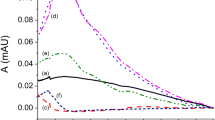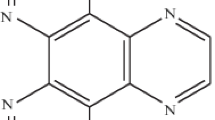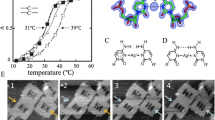Abstract
We measured the DNA strand-breaking activity of nanoparticle by agarose gel electrophoresis. Plasmid DNA was mixed with nanosilver and nano-silica powders in an aqueous solution. Then the mixture was applied to 1% of agarose gel electrophoresis at 75 V for 30 min. We used 300 nm of UV irradiation in order to visualize the DNA bands. The DNA strand-breaking activity of nanomaterial was measured through measuring the reduction of super-coiled DNA to circular form of DNA.
Similar content being viewed by others
Avoid common mistakes on your manuscript.
Background
Nanotechnology has been growing rapidly in the industry during the last decade. Because of the different physiochemical properties of nanomaterials, they provide novel scientific and industrial applications compared with their bulk substances [1]. In the field of medicine and biology, nanomaterials are showing a bright future with a diversity of applications including drug delivery [2], cancer targeting and tumor reduction [3], fluorescent biological labels [4], biodetection of pathogens [5], detection of proteins [6], probing of DNA structure [7], tissue engineering [8], intracellular hyperthermia [9] and separation, and purification of biological molecules and cells [10]. Nevertheless, information on the toxicity and potential dangers of nanomaterial is far from sufficient [11, 12].
Despite the many uses of nanotechnology in biology, they can be very harmful. The specific characteristics of nano-particles, i.e., their high surface area to mass ratio and their small size, have made them ideal candidates for many uses [13]. These characteristics, however, can be dangerous to our biological health. Because of their small size, nanoparticles can penetrate into cells and due to their high surface area to mass ratio, they are highly reactive. Hence, they can cause ample changes inside the cells, from reacting with proteins to attaching to DNA. For example, silver nano-particles have been shown toxic on mammalian cells [14]. The increasing exposure possibility of human to nano-particles [15] makes it very important to be aware of potential dangers.
There have been several papers on the toxicity of nano-particles on human and mammalian cells [16–18]. However, there are not many studies investigating the physical influence of nano-particles on DNA. There are also fewer papers studying the actual physical effect of nano-materials on DNA, regardless of their biological effects. This is especially important because these physical outcomes of DNA- nano-particle contact may well affect the result of a range of other studies from using DNA as a polymer to biological studies.
In this study we aim to compare the strand-breaking effect of two nano-particles, i.e., silver nano-particles and silica nanoparticles. Silver nano-particles are used for their antibacterial properties, hence are in close contact with the human body. Also, silica nano-particles are bioactive material with applications in drug delivery [19]. It is not only important to know the effect of each nano-particle on DNA, but also to compare their effect sizes. To our knowledge, no similar study has been conducted on these nano-materials. The aim of this study is to show how much difference can be expected, and further experiments using more variety of nano-particles are required in order to draw a full picture of their effects on DNA.
Results and discussion
Both silver and silica nanoparticles showed similar strand-breaking effect on plasmid DNA. Figure 1 shows gel electrophoresis of the effect of silver nano-particles on DNA. As we see, in Figure 1, plasmid DNA treated with silver nanoplates has been deformed from super-coiled to open circular DNA. This shows that the nano-particles have broken the DNA. However, compared with silica nano-particles, silver nano-plates show less strand-breaking activity. We can see this effect in Figure 2, where more DNA has been broken to open circular form. Also in Figure 2, we can see that more dense forms of plasmid have been broken to open forms, thus several bands are not present in the solutions of plasmid and nano-particles.
Strand-breaking effect of silver nanoplate on Escherichia coli plasmid DNA. From right to left, lane 1 is ladder, lane 2 is bacterial plasmid treated with silver nanoplates, lane 3 is untreated plasmid, and the last two lanes are negative and positive control, respectively. Lower bands represent less dense form of DNA, i.e., open circular DNA, and upper bands represent denser form of DNA, i.e., super-coiled DNA.
Comparing DNA strand-breaking effect of silver nanoplates and silica nano-particles. From right to left, lane 1 is ladder, lane 2 is bacterial plasmid treated with silver nanoplates, lane 3 is untreated plasmid, and lane 4 is bacterial plasmid treated with silica nano-particles. Lower bands represent less dense form of DNA, i.e., open circular DNA, and upper bands represent denser form of DNA, i.e., super-coiled DNA.
Conclusions
We have shown that silver and silica nano-particles have severe strand-breaking effects on DNA. This study only focused on the chemical effect of nano-particles on DNA and did not include biological effect. Therefore, it is possible to observe the effects with different level of intensities when cells are exposed to nanoparticles. However, this study suggests that nanomaterial can cause dangerous biological changes when in close contact with the body.
We also compared the effect size of silver and silica nanoparticles. It is concluded that silica causes bigger effect size and is more capable of breaking DNA strands. Since both of these nano-materials are gaining more applications in medicine, they should be used with enough care.
As we see in this study, nano-materials can act differently from their bigger size counterparts. This is because of extremely big surface area to mass ratio that makes them very reactive. Therefore, we expect to observe similar effects from other nano-materials. Hence, more studies comparing the influence of several different nano-materials on DNA are required.
Methods
Plasmid DNA was extracted from Escherichia coli using alkaline lysis (following the protocol by Sambrook and Russell [20]). We identified the purity of plasmid by OD260/OD280 ratio which was 1.81.
We used silver nanoplates [21] and silica nanoparticles for this study. We used silver nanoplates because in a study shown by Sadeghi et al. [22], silver nanoplates are more biologically active than silver nanoparticles and silver nanorods [23, 24]. Thus, they can possibly show better effect values of DNA strand-breaking activity. We used the nanoplates synthesized by our group [21]. Silica nanoparticles (SiO2) were purchased from Sigma-Aldrich (10 to 20 nm, 99.5%; Sigma-Aldrich Corporation, St. Louis, MO, USA).
We measured the DNA strand-breaking activity of the nano-particle by agarose gel electrophoresis. Plasmid DNA was mixed with nanosilver and nanosilica powders in an aqueous solution. Then they were applied to 1% of agarose gel electrophoresis at 75 V for 30 min. After that, we added ethidium bromide to tris-borate-EDTA gel buffer. We used 300 nm of UV irradiation in order to visualize the DNA bands. The DNA strand-breaking activity of the nanomaterial was measured by measuring the reduction of super-coiled DNA to circular form of DNA.
Authors’ information
BS is a lecturer of Inorganic and Nano Chemistry in Department of Chemistry, Tonekabon Branch, Islamic Azad University Tonekabon, Iran. ARV is a Ph.D. student in the University of Zurich.
References
Oberdorster G, Oberdorster E, Oberdorster : An Emerging Discipline Evolving from Studies of Ultrafine Particles. Environmental Health Perspectives. J: Environ. Heal. Perspect. 2005, 113: 823–839. 10.1289/ehp.7339
Pantarotto D, Tarotto D, Partidos CD, Hoebeke J, Brown F, Kramer E, Briand JP, Muller S, Prato M, Bianco A: Immunization with peptide-functionalized carbon nanotubes enhances virus-specific neutralizing antibody responses. Chem. Biol. 2003, 10: 961–966. 10.1016/j.chembiol.2003.09.011
Sosnik A, Carcaboso AM, Glisoni RJ, Moretton MA, Chiappetta DA: New old challenges in tuberculosis: potentially effective nanotechnologies in drug delivery. Adv. Drug. Deliver. Rev. 2010, 62: 547–559. 10.1016/j.addr.2009.11.023
Wang SP, Mamedova N, Kotov NA, Chen W, Studer J: Antigen/antibody immunocomplex from CdTe nanoparticle bioconjugates. Nano. Lett. 2002, 2: 817–822. 10.1021/nl0255193
Edelstein RL, Tamanaha CR, Sheehan PE, Miller MM, Baselt DR, Whitman LJ, Colton RJ: The BARC biosensor applied to the detection of biological warfare agents. Biosens. Bioelectron. 2000, 14: 805–813. 10.1016/S0956-5663(99)00054-8
Nam JM, Thaxton CS, Mirkin CA: Nanoparticle-based bio-bar codes for the ultrasensitive detection of proteins. Science 2003, 301: 1884–1886. 10.1126/science.1088755
Mahtab R, Rogers JP, Murphy CJ: Protein-sized quantum-dot luminescence can distinguish between straight, bent, and kinked oligonucleotides. J. Am. Chem. Soc. 1995, 117: 9099–9100. 10.1021/ja00140a040
Ma J, Wong HF, Kong LB, Peng KW: Biomimetic processing of nanocrystallite bioactive apatite coating on titanium. Acs. Sym. Ser. 2003, 14: 619–623.
Shinkai M, Yanase M, Suzuki M, Honda H, Wakabayashi T, Yoshida J, Kobayashi T: Intracellular hyperthermia for cancer using magnetite cationic liposomes. J. Magn. Magn. Mater. 1999, 194: 176–184. 10.1016/S0304-8853(98)00586-1
Molday RS, Mackenzie D: Immunospecific ferromagnetic iron-dextran reagents for the labeling and magnetic separation of cells. J. Immunol. Methods 1982, 52: 353–367. 10.1016/0022-1759(82)90007-2
Nel A, Xia T, Madler L, Li N: Toxic potential of materials at the nanolevel. Science 2006, 311: 622–627. 10.1126/science.1114397
Matsumura Y, Yoshikata K, Kunisaki S, Tsuchido T: Mode of bactericidal action of silver zeolite and its comparison with that of silver nitrate. Appl. Environ. Microbiol. 2003, 69: 4278–4281. 10.1128/AEM.69.7.4278-4281.2003
Kim JS, Kuk E, Yu KN, Kim JH, Park SJ, Lee HJ, Kim SH, Park YK, Park YH, Hwang CY, Kim YK, Lee YS, Jeong DH, Cho MH: Antimicrobial effects of silver nanoparticles. Nanomed-Nanotechnol. 2007, 3: 95–101. 10.1016/j.nano.2006.12.001
Braydich-Stolle L, Hussain S, Schlager JJ, Hofmann MC: In vitro cytotoxicity of nanoparticles in mammalian germline stem cells. Toxicol. Sci. 2005, 88: 412–419. 10.1093/toxsci/kfi256
Kulthong K, Srisung S, Boonpavanitchakul K, Kangwansupamonkon W, Maniratanachote R: Determination of silver nanoparticle release from antibacterial fabrics into artificial sweat. Particle and Fibre Toxicology 2010., 7:
Ahamed M, Alsalhi MS, Siddiqui MKJ: Silver nanoparticle applications and human health. Clin. Chim. Acta. 2010, 411: 1841–1848. 10.1016/j.cca.2010.08.016
Zhu RR, Wang SL, Chao J, Shi DL, Zhang R, Sun XY, Yao SD: Bio-effects of nano-TiO2 on DNA and cellular ultrastructure with different polymorph and size. Mat. Sci. Eng. C-Bio. S 2009, 29: 691–696. 10.1016/j.msec.2008.12.023
Martinez-Gutierrez F, Olive PL, Banuelos A, Orrantia E, Nino N, Sanchez EM, Ruiz F, Bach H, Av-Gay Y: Synthesis, characterization, and evaluation of antimicrobial and cytotoxic effect of silver and titanium nanoparticles. Nanomed-Nanotechnol. 2010, 6: 681–688. 10.1016/j.nano.2010.02.001
Chen JF, Ding HM, Wang JX, Shao L: Preparation and characterization of porous hollow silica nanoparticles for drug delivery application. Biomaterials. 2004, 25: 723–727. 10.1016/S0142-9612(03)00566-0
Sambrook J, Russell DW: Molecular cloning: a laboratory manual. Cold Spring Harbor: Cold Spring Harbor Laboratory Press; 2001.
Sadeghi B, Sadjadi MAS, Vahdati RAR: Nanoplates controlled synthesis and catalytic activities of silver nanocrystals. Superlattice. Microst. 2009, 46: 858–863. 10.1016/j.spmi.2009.10.006
Sadeghi B, Garmaroudi FS, Hashemi M, Nezhad HR, Nasrollahi A, Ardalan S, Ardalan S: Comparison of the anti-bacterial activity on the nanosilver shapes: nanoparticles, nanorods and nanoplates. Adv. Powder. Technol. 2012, 23: 22–26. 10.1016/j.apt.2010.11.011
Sadeghi B, Jamali M, Kia S, Amininia A, Ghafari S: Synthesis and characterization of silver nanoparticles for antibacterial activity. Int. J. Nano Dimens 2010, 1: 119–124.
Sadjadi MAS, Sadeghi B, Meskinfam M, Zare K, Azizian J: Synthesis and characterization of Ag/PVA nanorods by chemical reduction method. Physica. E 2008, 40: 3183–3186. 10.1016/j.physe.2008.05.010
Acknowledgment
The financial and encouragement support was provided by the research vice-president and the Young Research Club of Islamic Azad University-Tonekabon Branch and the executive director of Iran Nanotechnology Organization (Government of Iran).
Author information
Authors and Affiliations
Corresponding author
Additional information
Competing interests
The authors declare that they have no competing interests.
Authors’ contributions
BS carried out the synthesis of silver and gold nano-particles studies. ARV performed the experiments on the effect of nanoparticles on DNA. Both authors read and approved the final manuscript.
Authors’ original submitted files for images
Below are the links to the authors’ original submitted files for images.
Rights and permissions
Open Access This article is distributed under the terms of the Creative Commons Attribution 2.0 International License (https://creativecommons.org/licenses/by/2.0), which permits unrestricted use, distribution, and reproduction in any medium, provided the original work is properly cited.
About this article
Cite this article
Vahdati, A.R., Sadeghi, B. A study on the assessment of DNA strand-breaking activity by silver and silica nanoparticles. J Nanostruct Chem 3, 7 (2013). https://doi.org/10.1186/2193-8865-3-7
Received:
Accepted:
Published:
DOI: https://doi.org/10.1186/2193-8865-3-7






